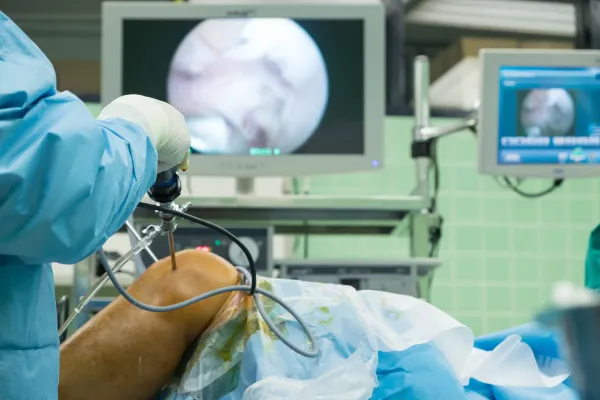Orthopedic Coding Alert
Ace ACL Claims with these Tips

Look for evidence of arthroscopic aid on 29888 claims.
For professional athletes, weekend workout warriors and even folks who just enjoy a nice walk, an anterior cruciate ligament (ACL) injury is painful and can affect a patient's mobility for the rest of their lives.
In short, it's a serious injury that needs plenty of treatment - often starting with an ACL repair by an orthopedist.
When you're coding for these procedures, be sure you don't get the codes twisted. Read on for more ACL repair coding advice, and check it the next time a patient reports for treatment of a knee injury.
Know the ACL Repair Terms
In order to code your ACL repair claim correctly, you'll first need to know what constitutes a codeable ACL repair, and is thus eligible for 29888 (Arthroscopically aided anterior cruciate ligament repair/augmentation or reconstruction). This is often opaque in the operative report, as the provider might use terms synonymous with ACL repair to describe the procedure.
Quick definition: "ACL repair is [repair] for a torn or ruptured ACL ligament," explains Denise Paige, CPC, COSC, orthopedic surgery coder at PIH Health in Whittier, California.
Also: If the notes state that the provider used a graft to replace the damaged ACL, or sews the ends of the ACL together, then you might have a 29888 claim on your hands.
The operative report for a 29888 claim "would describe a repair rather than a debridement. This would include the placement of a graft or suturing, as well as the use of anchors to secure the ACL to bone," relays Lynn M. Anderanin, CPC, CPMA, CPPM, CPC-I, COSC, senior director of coding education at Healthcare Information Services in Park Ridge, Illinois.
Remember, Surgical Techniques Can Vary
When your provider performs an ACL repair, there are several surgical techniques she might employ that are all eligible for 29888 coding. Some surgical techniques you might find mentioned in 29888 claims include:
- Bone-patella-bone reconstruction,
- Hamstring reconstruction,
- Allograft reconstruction,
- Extra-articular reconstruction, and
- Double bundle reconstruction.
In reality, the orthopedist can use any arthroscopic method to repair the ACL, according to Anderanin.
"The important part here is that the [29888] CPT® code description states 'arthroscopically aided;' so there may be some form on incision made as partof the procedure, and the whole procedure may not be performed through the scope."
Check Out this Clinical Scenario
Three weeks ago, an established patient reported with left knee pain. After an evaluation and management (E/M) service that includes an in-office knee X-ray, the provider sends the patient to another facility for magnetic resonance imaging (MRI), which confirms an ACL tear.
Today, the patient reports to the orthopedist for ACL repair. Operative notes indicate that the orthopedist used arthroscopy to perform bone-patella-bone reconstruction on the ACL. For this encounter, you'd report 29888 for the repair.
Modifier alert: If your insurer requires a laterality modifier, be sure to append modifier LT (Left side) to 29888 to show which knee the provider repairs.
29888 Includes Most Services, Supplies
While there are some situations in which you'd report a separate procedure or supply code along with 29888, most services associated with ACL repair are bundled into the code.
"CPT® code 29888 pretty much covers everything in surgery performed by the surgeon; the facility may charge separately for supplies such has grafts, hardware, drugs, etc.," explains Paige.
Exception: According to Anderanin, there might be instances in which you can report 29888 with another arthroscopic procedure in the same session, such as 29874 (Arthroscopy, knee, surgical; for removal of loose body or foreign body (eg, osteochondritis dissecans fragmentation, chondral fragmentation)) or 29880 (... with meniscectomy (medial AND lateral, including any meniscal shaving) including debridement/shaving of articular cartilage (chondroplasty), same or separate compartment(s), when performed).
Orthopedists might also perform an ACL reconstruction in tandem with other procedures, such as menisectomy or meniscal repair.
You might need to check with your payer before reporting 29888 with another procedure. The payer might only accept such claims under certaincircumstances, it might require use of a specific modifier - or it might forbid you from reporting bothservices.
Better to be safe than sorry. If you have any doubt at all as to whether you can report 29888 with another procedure, check with the payer first.
Related Articles
Orthopedic Coding Alert
- Knee Surgery:
Ace ACL Claims with these Tips
Look for evidence of arthroscopic aid on 29888 claims. For professional athletes, weekend workout warriors [...] - Knee Surgery:
Know Your Anatomy Front and Back for Cruciate Ligament Repairs
ACL, PCL repairs are different sides of the same coin. When most people think of [...] - E/M Coding:
Observe Different Rules for Medicare, Private Payer Consults
You can't use CPT® codes for Medicare consults. When your orthopedist is called for a [...] - Modifiers:
Experts: G Modifiers Gaining Steam Toward Mainstream
GA is now required by many Medicare payers to indicate ABN. When your provider performs [...] - You Be the Coder:
Go to 7th Spot for Fracture Dx
Question: Noted indicate that the orthopedist treated a patient with a closed oblique fracture of [...] - Reader Question:
Determine Site for Definitive Debridement Documentation
Question: One of our patients was recently involved in a skateboard accident, which resulted in [...] - Reader Question:
1 Code Covers Aspiration, Injection of Same Joint
Question: How do I code a scenario in which the provider performs a knee aspiration [...]




